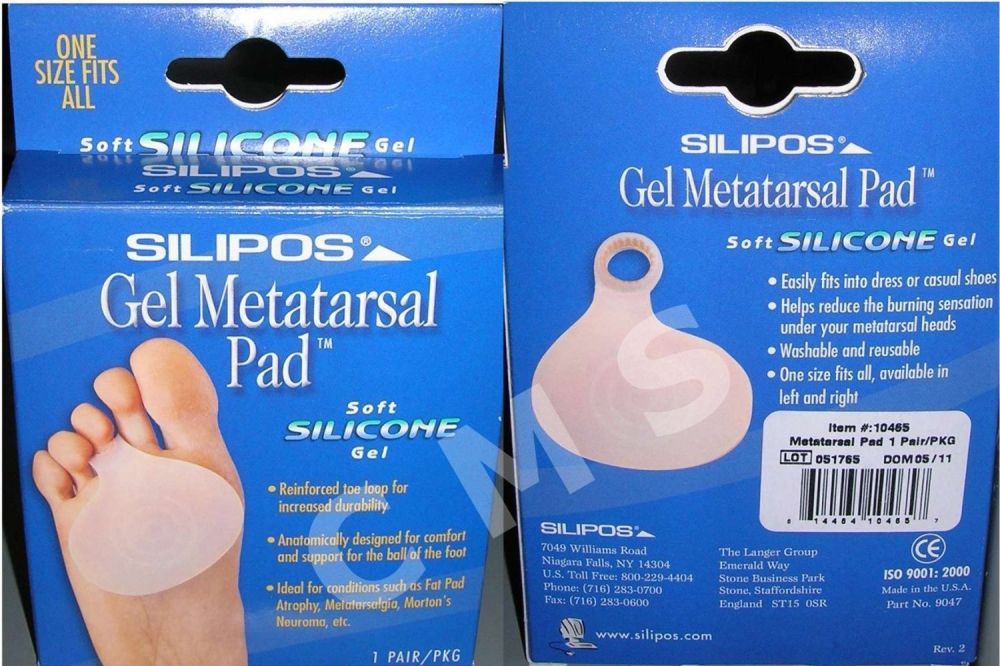There are many causes of foot pain, but if you are experiencing a sharp, stabbing pain that feels better when you stop walking and massage your foot, you may have what's known as Morton's neuroma. While it has a scary sounding name, this condition is benign and fortunately highly treatable.
In basic terms, a neuroma is an enlargement or thickening of a nerve in the foot in the area between the toes,
usually the third interspace between the third and fourth toes, followed by the second interspace between the second and third toes. Morton's neuromas can rarely affect the fourth and first interspaces.
It is also sometimes referred to as an intermetatarsal neuroma, interdigital neuroma, Morton's metatarsalgia (pain in the metatarsal area), perineural fibrosis (scar tissue around a nerve) or entrapment neuropathy (abnormal nerve due to compression).
If you have a Morton's neuroma, there is a 15% chance you will develop it in both feet. Morton's neuromas occur most commonly in women who are between 30 to 50 years old, often due to poor-fitting shoes.
Causes of Morton's Neuroma: Injury or Poor Biomechanics
A Morton's neuroma is thought to be caused by an injury to the nerve, but scientists are still not sure about the exact cause of the injury. The injury may be caused by damage to the metatarsal heads, the deep transverse intermetatarsal ligament (holds the metatarsal heads together) or an intermetatarsal bursa (fluid-filled sac). All of these structures can cause compression and injury to the nerve, initially causing swelling and damage in the nerve. Over time, if the compression/injury continues, the nerve repairs itself with very fibrous tissue that leads to enlargement and thickening of the nerve.Other
causes of injury to the nerve may include simply having anincorrect walking style or an awkward foot structure, such as overpronation (foot rolls inward), hypermobility (too much motion), cavo varus (high arch foot) and excessive dorsiflexion (toes bend upward) of the toes.
These biomechanical (how the foot moves) factors may cause injury to the nerve with every step. If the nerve becomes irritated and enlarged, then it takes up more space and gets even more compressed and irritated. It becomes a vicious cycle.
Signs & Symptoms of Morton's Neuroma
Initially these symptoms may happen once in a while, but as the condition gets worse, the symptoms may happen all of the time. It usually feels better by taking off your shoe and massaging your foot.
- Pain (sharp, stabbing, throbbing, shooting)
- Numbness
- Tingling or "pins & needles"
- Burning
- Cramping
- A feeling that you are stepping on something or that something is in your shoe
How a Diagnosis Is Made
Your podiatrist (foot doctor) will ask many questions about your signs and symptoms and will perform a physical exam. Some of the exams may include a web space compression test. This is done by squeezing the metatarsals (the bones just below the toes) together with one hand and using the thumb and index finger of the other hand to compress the affected area to reproduce the pain/symptoms. A palpable click (Mulder's click) is usually present. This test may also cause pain to shoot into the toes and that is called a Tinel's sign. Gauthier's test involves squeezing the metatarsals together and moving them up and down for 30 seconds. This will usually cause pain or it will bring on your other symptoms.Sullivan's sign is positive when you stand and the affected toes spread apart.A Morton's neuroma is usually diagnosed based on the history and physical exam findings, but sometimes other tests such as an x-ray, ultrasound or an MRI are needed.
Treatment Options
- Wear shoes that are wide and deep in the toe box so they do not put pressure on your toes and metatarsals. Avoid wearing high heels because they cause increased pressure on the ball of your foot (forefoot).
- Metatarsal pads: These help to lift and separate the metatarsal heads to take pressure off of the nerve. They are placed just behind where you feel the pain, not on top of the painful spot.

- Activity modification: For example, you may try swimming instead of running until your symptoms go away.
- Taping with athletic tape
- Icing
- NSAIDs (anti-inflammatory medications): Aleve, ibuprofen, etc.
- Arch supports or orthotics: These help to control some of the abnormal motion in your feet. The abnormal motion can lead to extra torque and pressure on the nerve.

- Physical therapy
- Cortisone injection: Helps to decrease the size of the irritated, enlarged nerve.
- Alcohol injection: Helps to destroy the nerve chemically.
- Surgery: If conservative treatment does not help surgery may be needed. Surgery may involve cutting out the nerve or cutting the intermetatarsal ligament. Studies have shown surgery has an 80-85% success rate.
Prevention of a Morton's Neuroma
- Avoid wearing narrow, pointed toe shoes
- Avoid wearing high heel shoes





